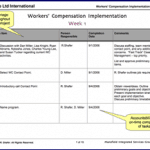“When selecting a broker, biggest isn’t necessarily best.” One of the most important decisions a company makes is selecting their insurance broker. Most large companies have brokers rather than agents so they can obtain coverage from a number of different insurance carriers rather than just one. An agent is a representative of one insurance company. …
Workers Comp Articles
Medical Cost Containment Strategies
Look at the Total Loss Costs (TLC), Not Just the Line-by-Line Items. The best technique to control medical costs in workers’ compensation is a Total Loss Cost (TLC) approach. To be truly effective in controlling the medical cost of workers’ compensation, employers and insurers should not limit their medical cost containment efforts to only one …
Management Roles and Responsibilities In A Workers Compensation Program
Employers who take control and direct the management of their workers compensation injury claims are most likely to see the best results in cost savings. The personnel involved often include the workers compensation claim coordinator, the floor or field supervisors, mid-management, medical personnel, legal, senior management and even the employees. Management Roles and Responsibilities The …
Proven Strategies & Tactics to Lower Workers Comp Costs
TALK TO AN EXPERT FOR FREE Chat: Click for Live Chat Phone: 207-281-2599 Email: info@ReduceYourWorkersComp.com
Phase 1: Assessment & Recommendation
Workers’ Comp Improvement Plan – Phase One Team Selection and Information Gathering Phase One – Steps 1 through 9 The steps in the Assessment & Recommendation Phase involve selecting a team and gathering information about your current program, including vendor partners, associated claims, and reported losses. STEP 1: ASSEMBLE PROJECT TEAM The Injury Management Planning …
Phase 2: Design & Development
Workers’ Comp Improvement Plan – Phase 2 Program Material Development Phase Two – Step 10 The steps in the Design & Development Phase involve developing all materials (templates, forms, sample letters, etc.) that will be used through the life of the program. STEP 10: DESIGN FORMS AND PROCEDURES Many forms will be designed during this …
Phase 3: Training & Implementation
Workers’ Comp Improvement Plan – Phase 3 All Employees from Top to Bottom Phase Three – Steps 11 through 13 The steps in the Training & Implementation Phase involve a training program for all employees from top management to individual workers who are involved in the workers’ compensation/injury management process. Employees will be up-to-date and …
Phase 4: Monitoring & Management
Phase Four – Step 14 The steps in the Monitoring & Management Phase involve posting implementation support and monitoring of processes, injury claims, and lost time data. STEP 14: MONITORING THE PROGRAM After implementation, the company should be able to demonstrate results through: Declining injury rates A shift in the Return to Work Ratio showing …
Claim Handling: Workers Compensation Best Practices
“Best practices” are often referenced in the handling of workers compensation claims without an explanation as to what they are or what the insurance industry standards are for handling workers compensation claims. While “best practices” vary slightly from insurance company to insurance company, here is a synopsis of the basic standards of how the insurance …
Three Ways to Cut Workers Comp Costs
By Rebecca A. Shafer – August 2011 Limiting workers compensation claims costs requires finding and filling gaps within the process. To do so, you must work closely with your claims administrator. Here are three ways to cut costs. #1. Arrange a Chairside Visit A chairside visit, in which the employer representative sits down with an …











